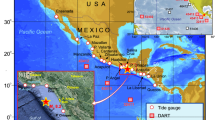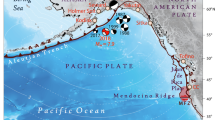Abstract
At 12:15 on January 15, 2022 (Beijing time), a massive eruption of the Hunga Tonga-Hunga Ha’apai volcano produced violent atmospheric fluctuations, which in turn generated a global tsunami through an abrupt air pressure shock upon the sea surface. Two main components of tsunami waves, phase-locked waves and free gravity waves, were identified by significant differences in propagating speeds across the deep ocean. The phase-locked wave propagated through the ocean basin synchronously with the atmospheric Lamb wave at an average speed of approximately 306 m/s, followed by the free gravity wave at a slower speed. The locked wave reached the coast of eastern Taiwan Island at about 20:00 on January 15, in coincidence with the Lamb wave arrival. However, on the coast of Chinese mainland, tidal gauges did not record tsunami signals until at least 2 h after the Lamb wave arrivals. Theoretical analyses and numerical experiments both suggested that as a result of the incoming wave shoaling above the vast continental shelf of Chinese mainland, the locked wave was no longer trapped by the air pressure shock and gradually transformed into freely-propagating shallow water waves by slowing down its propagation. Due to the long-lasting planetary atmospheric fluctuations circling the earth many times, the sea level oscillations continuously propagated onto the Chinese shelf, which resulted in the tsunami waves excited along the Chinese coasts for at least 36 h. The maximum wave amplitude recorded on the coast of eastern Taiwan Island was 44 cm at Wushi, while on the coasts of eastern and southern Chinese mainland, the maximum amplitudes were 22 cm at Shipu and 13 cm at Zhuhai. Fourier and wavelet analyses were performed to identify the major components of the tsunami waves on the Chinese coasts. The results indicated that eastern Taiwan Island was impacted mainly by the waves with periods of approximately 10–40 min. Chinese mainland was hit by the evolved shallow water waves and subsequent free waves, with periods of approximately 40–100 and 16–20 min, respectively.
Similar content being viewed by others
References
Amores A, Monserrat S, Marcos M, Argüeso D, Villalonga J, Jordà G, Gomis D. 2022. Numerical simulation of atmospheric Lamb waves generated by the 2022 Hunga-Tonga volcanic eruption. Geophys Res Lett, 49: e98240
Borrero J C, Cronin S J, Latu’ila F H, Tukuafu P, Heni N, Tupou A M, Kula T, Fa’anunu O, Bosserelle C, Lane E, Lynett P, Kong L. 2022. Tsunami runup and inundation in Tonga from the January 2022 eruption of Hunga volcano. Pure Appl Geophys, 180: 1–22
Carvajal M, Sepúlveda I, Gubler A, Garreaud R. 2022. Worldwide signature of the 2022 Tonga volcanic tsunami. Geophys Res Lett, 49: e98153
Heidarzadeh M, Satake K. 2015. New insights into the source of the Makran tsunami of 27 November 1945 from tsunami waveforms and coastal deformation data. Pure Appl Geophys, 172: 621–640
Herrera M T R, Coca O, Espinosa V. 2022. Tsunami effects on the Coast of Mexico by the Hunga Tonga-Hunga Ha’apai volcano eruption, Tonga. Pure Appl Geophys, 179: 1117–1137
Hu G, Li L, Ren Z, Zhang K. 2022. The characteristics of the 2022 Tonga volcanic tsunami in the Pacific Ocean. Nat Hazards Earth Syst Sci Discuss, 23: 675–691
Kubota T, Saito T, Nishida K. 2022. Global fast-traveling tsunamis driven by atmospheric Lamb waves on the 2022 Tonga eruption. Science, 377: 91–94
Liu P L F, Higuera P. 2022. Water waves generated by moving atmospheric pressure: Theoretical analyses with applications to the 2022 Tonga event. J Fluid Mech, 951: A34
Lynett P, McCann M, Zhou Z, Renteria W, Borrero J, Greer D, Fa’anunu O, Bosserelle C, Jaffe B, La Selle S P, Ritchie A, Snyder A, Nasr B, Bott J, Graehl N, Synolakis C, Ebrahimi B, Cinar G E. 2022. Diverse tsunamigenesis triggered by the Hunga Tonga-Hunga Ha’apai eruption. Nature, 609: 728–733
Manneela S, Kumar S. 2022. Overview of the Hunga Tonga-Hunga Ha’apai volcanic eruption and tsunami. J Geol Soc India, 98: 299–304
Otsuka S. 2022. Visualizing Lamb waves from a volcanic eruption using meteorological satellite Himawari-8. Geophys Res Lett, 49: e98324
Pan W L, Wang S A, Sun L, Long X M. 2014. Observed waveform and characteristics of the 2010 Chile and 2011 Japan tsunamis near the coast of South China (in Chinese). J Tropic Oceanogra, 33: 17–23
Proudman J. 1929. The effects on the sea of changes in atmospheric pressure. Geophys J Int, 2: 197–209
Saito T, Kubota T, Chikasada N Y, Tanaka Y, Sandanbata O. 2021. Meteorological tsunami generation due to sea-surface pressure change: Three-dimensional theory and synthetics of ocean-bottom pressure change. J Geophys Res Oceans, 126: e2020JC017011
Sekizawa S, Kohyama T. 2022. Meteotsunami observed in Japan following the Hunga Tonga eruption in 2022 investigated using a one-dimensional shallow-water model. SOLA, 18: 129–134
Tadepalli S, Synolakis C E. 1994. The run-up of N-waves on sloping beaches. Proc R Soc Lond A, 445: 99–112
Tanioka Y, Yamanaka Y, Nakagaki T. 2022. Characteristics of the deep sea tsunami excited offshore Japan due to the air wave from the 2022 Tonga eruption. Earth Planets Space, 74: 61
Torrence C, Compo G P. 1998. A practical guide to wavelet analysis. Bull Amer Meteor Soc, 79: 61–78
Wang P T, Yu F J, Zhao L D, Fan T T, Hou J M. 2012. Numerical analysis of tsunami propagating generated by the Japan Mw9.0 earthquake on Mar.11 in 2011 and its impact on China coasts (in Chinese). Chi J Geophy, 55: 3088–3096
Welch P. 1967. The use of fast Fourier transform for the estimation of power spectra: A method based on time averaging over short, modified periodograms. IEEE Trans Audio Electroacoust, 15: 70–73
Williams D A, Horsburgh K J, Schultz D M, Hughes C W. 2021. Proudman resonance with tides, bathymetry and variable atmospheric forcings. Nat Hazards, 106: 1169–1194
Xie S Y, Shang S P, Wei Yan, Zhang L. 2012. Effect of the 2010 Chile Ocean Tsunami on Seas Surrounding Taiwan (in Chinese). J Xiamen Univ-Natur Sci, 51: 898–902
Yu F J, Yuan Y, Zhao L D, Wang P T. 2011. Evaluation of potential hazards from teletsunami in China: Tidal observations of a teletsunami generated by the Chile 8.8 Mw earthquake. Chin Sci Bull, 56: 1108–1116
Yuan Y, Li H, Wei Y, Shi F, Wang Z, Hou J, Wang P, Xu Z. 2021. Probabilistic Tsunami Hazard Assessment (PTHA) for southeast coast of Chinese mainland and Taiwan Island. J Geophys Res Solid Earth, 126: e2020JB020344
Zengaffinen T, Løvholt F, Pedersen G K, Muhari A. 2020. Modelling 2018 Anak Krakatoa Flank Collapse and Tsunami: Effect of landslide failure mechanism and dynamics on tsunami generation. Pure Appl Geophys, 177: 2493–2516
Acknowledgements
We thank Paul Wessel for leading the development of the GEOWARE-TTT (Tsunami Travel Time) software (http://www.geoware-online.com), which was used to calculate the theoretical estimated time of tsunami arrivals in this paper. This work was supported by the National Key Research and Development Program of China (Grant No. 2022YFC3003800), and the Asian Cooperation Fund Project (Grand No. 99950410).
Author information
Authors and Affiliations
Corresponding author
Rights and permissions
About this article
Cite this article
Wang, Z., Xu, Z., Yuan, Y. et al. How did the Tonga volcanic tsunami on January 15, 2022, affect Chinese coasts?. Sci. China Earth Sci. 66, 1038–1046 (2023). https://doi.org/10.1007/s11430-022-1090-9
Received:
Revised:
Accepted:
Published:
Issue Date:
DOI: https://doi.org/10.1007/s11430-022-1090-9




